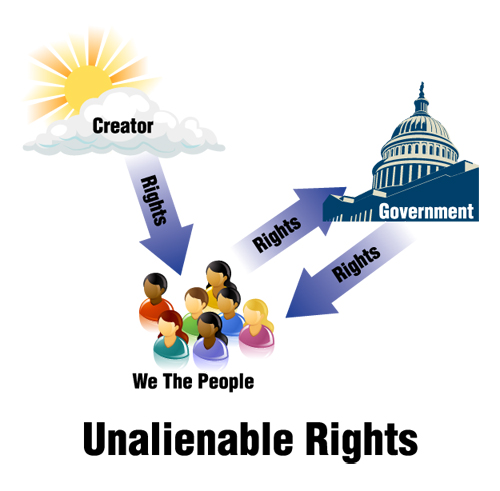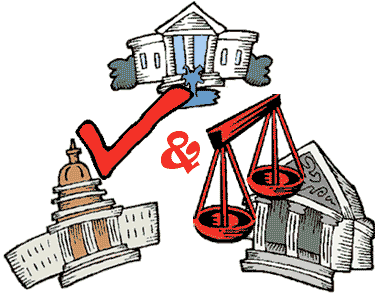|
Core Principles of the Constitution
The Second Amendment is imbued with the core principles of the Constitution of the United States of America. Here is a cursory discussion of two core principles and their relation to the Second Amendment. (We found our local library and book stores provided more credible resources than surfing the web. So take a trip, you'll be glad you did.) The first core principle of the Constitution comes from the opening of the Declaration of Independence that all men (a term we will use loosely to mean all men and women) are “endowed by their Creator with certain unalienable Rights, that among these are life, Liberty and the Pursuit of happiness”. The Constitution expands on this principle in several ways, such as the 4 th Amendment (which includes unlawful search and seizure) and the 9 th and 10 th Amendments which (generically) grant rights and powers not specifically assigned to the government to the people of the country. One aspect of the Second Amendment is an extension of these unalienable Rights given to us by our Creator - the unalienable Right of self defense in protection of our life, liberty and property.  To Americans, it is self evident that unalienable Rights such as life, liberty, pursuit of happiness, property and self defense do not come from any man-made institution (including any form of government) for no such institution is more powerful than the Creator of the men forming and serving within that institution. Further, any Right "given" by a government can be taken away by that same government. Embracing this core principle is central to understanding The United States of America, as well as Americans and the Second Amendment.
To Americans, it is self evident that unalienable Rights such as life, liberty, pursuit of happiness, property and self defense do not come from any man-made institution (including any form of government) for no such institution is more powerful than the Creator of the men forming and serving within that institution. Further, any Right "given" by a government can be taken away by that same government. Embracing this core principle is central to understanding The United States of America, as well as Americans and the Second Amendment.
|
||
 The second core principle of the Constitution is human nature, in all of its virtue and frailty. Echoing the Declaration of Independence, the introduction of the Constitution lays clear that the purpose of government is to enrich the lives of the governed, to "form a more perfect Union, establish Justice, insure domestic Tranquility, provide for the common defense, promote the general Welfare, and secure the Blessings of Liberty to ourselves and our Posterity". These are lofty and virtuous goals that clearly place the government as subordinate to the Rights of the individual.
The second core principle of the Constitution is human nature, in all of its virtue and frailty. Echoing the Declaration of Independence, the introduction of the Constitution lays clear that the purpose of government is to enrich the lives of the governed, to "form a more perfect Union, establish Justice, insure domestic Tranquility, provide for the common defense, promote the general Welfare, and secure the Blessings of Liberty to ourselves and our Posterity". These are lofty and virtuous goals that clearly place the government as subordinate to the Rights of the individual.
Where the Constitution is concerned, the most plainly visible human frailty is the effect of power to corrupt and the potential abuse of power against the governed. The writers of the Constitution knew that history was full of leaders that inflicted suffering and enslavement upon those they governed. So the Constitution was designed with rules for three branches of government to provide a check and balance on the other two branches against abuses of power. Similar formation of governmental bodies date back to 16 th century England.  The functioning of these branches are discussed in Article 1 (Legislative), Article 2 (Executive) and Article 3 (Judicial), which comprise roughly three quarters of the Constitution's text. Article 1, which sets the rules for how laws are made, is roughly half of the text itself. Article 4 (concerning state issues), Article 5 (the amendment process) and Articles 6 and 7 (administrative processes) comprise the remaining one quarter.
The functioning of these branches are discussed in Article 1 (Legislative), Article 2 (Executive) and Article 3 (Judicial), which comprise roughly three quarters of the Constitution's text. Article 1, which sets the rules for how laws are made, is roughly half of the text itself. Article 4 (concerning state issues), Article 5 (the amendment process) and Articles 6 and 7 (administrative processes) comprise the remaining one quarter.
Thus, nearly all of the Constitution is designed to protect the unalienable Rights of the individual by limiting and decentralizing the federal government to intentionally shackle and impede those that would seek to abuse power. So too the Second Amendment echoes the unalienable Right of the individual with the right to bare arms. Continue
|
||

|
||

Custom Search
|
||
